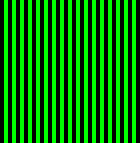
Every once in a while we like to post an optical illusion that’s trending in Japan at the moment, and this time around we bring you the McCollough effect. However, this is one optical illusion you probably shouldn’t go through with.
Don’t get us wrong, we’re going to post the illusion for the sake of reporting on it, but you might want to consider some of our other wonderful articles instead. I read a lovely piece about sacred horses the other day.
The reason we are dissuading you from checking out this optical illusion is that its effect might not go away for quite some time. Studies have reported some after-effects last over three months. So last chance to turn back and check out our list of beautiful Japanese train stations instead.
No? Okay suit yourself and don’t say we didn’t warn you…because we’re still going to continue to warn you.
First we’ll give you a chance to rethink what you’re about to look at back giving a brief back-story on the McCollough effect. This year is actually the 50th anniversary of its discovery by accomplished psychologist Celeste McCollough.
It’s believed to work on the concept of “neural adaptation” which is a fancy term for “getting used to stuff.” For example, put your hand on something and leave it there. You’ll notice that the sensation you feel in your hand of whatever your touch will gradually dim over time compared to when you first made contact with it. Do it long enough and you may even cease to feel it.
The same thing applies to your sense of vision…how exactly that is, no one is really sure. However mankind has been able to utilize it for some neat tricks like that one where you can see Jesus or celebrities in color on your wall. The basic idea is that if you get your brain used to looking at things a certain way it will take a little time to readjust if you suddenly change the environment.
However, the McCollough effect is especially weird because it can take a considerably longer time to readjust the way to see. Sometimes it can last over an hour, and in more extreme cases hang around for months.
Okay, we’ve probably bored some people out of long term visual weirdness, so on with the illusion! But first one last warning.
Don’t worry you still have a chance to back out since a casual glance at the McCollough illusion will have no effect. You’ll probably have to do at least about three minutes of staring total to get something going. Beyond that, the longer you look at them, the longer the after-effect will last.
First, here’s the final image you are going to look at. Now it should just look like a series of black lines on a white background. If you see anything more then you might be high or you’ve done this before and are still feeling the after-effects.
Next we’ll show you the two inducing images. They are scaled down to be the same size as the corresponding squares in the above image. To see the illusion stare at the center of the first image (red) for a few seconds and then look at the second one (green) for a few seconds. Then go back to the first image (red) for a few seconds and repeat this monotony for about three minutes.
We recommend playing this Pink Floyd song in the background to use as a timer. It’s great music to stare at lines and colors for longer than people normally do and should be just long enough for induction to occur.
_________________________________
Once you’ve done that, take a look at this picture again.
If it worked you should see a green and magenta hue around the horizontal and vertical bars respectively. The intensity may be different for different people depending on factors that aren’t entirely known such as possible mental illness, drug addiction, and/or color-blindness. For this writer it was a very mild glow around the edges of the bars and a very very weak cloud of the color in between the lines. Overall it was very disappointing. Here’s a computer simulation.
The crappy effect lasted for about an hour having stared at the inducer images for about five minutes. And if you were brave enough to try it then you’ll be stuck with it for a while too. See, we told you not to do it.
Let us know if you got something cooler, or if this is just a universal let-down as far as illusions go.
Source: Lenstore Vision Hub (English) via Byokan Sunday (Japanese)
Illusion Images: Wikipedia – Android Mouse 1, 2, 3
Warning & Simulation Images: RocketNews24
Video: YouTube – cfduns, ninofficial






 Maths professor from Japan’s optical illusions will have you doubting your own eyes【Video】
Maths professor from Japan’s optical illusions will have you doubting your own eyes【Video】 Brain-breaking optical illusion from Japan is a lie within a lie, truly amazing【Video】
Brain-breaking optical illusion from Japan is a lie within a lie, truly amazing【Video】 Cat in the desert becomes latest optical illusion to wow the internet in Japan
Cat in the desert becomes latest optical illusion to wow the internet in Japan Japan may add Japanese language proficiency, lifestyle classes to permanent foreign resident requirements
Japan may add Japanese language proficiency, lifestyle classes to permanent foreign resident requirements Disillusionment at Tsukiji’s tourist-target prices led us to a great ramen restaurant in Tokyo
Disillusionment at Tsukiji’s tourist-target prices led us to a great ramen restaurant in Tokyo Starbucks Japan releases new zodiac chilled cup drink for 2026
Starbucks Japan releases new zodiac chilled cup drink for 2026 Full-size Evangelion statue appears at Japanese theme park with entry plug synchronization tests
Full-size Evangelion statue appears at Japanese theme park with entry plug synchronization tests Is this the most relaxing Starbucks in Japan?
Is this the most relaxing Starbucks in Japan? 7-Eleven Japan starts new temporary luggage storage service in over 300 branches
7-Eleven Japan starts new temporary luggage storage service in over 300 branches Starbucks on a Shinkansen bullet train platform: 6 tips for using the automated store in Japan
Starbucks on a Shinkansen bullet train platform: 6 tips for using the automated store in Japan Dragon Quest Super Light Cafe draws near! Command?
Dragon Quest Super Light Cafe draws near! Command? Sanma-men, the best ramen type that everyone in Japan forgets about
Sanma-men, the best ramen type that everyone in Japan forgets about Lacquerware supplier to emperor of Japan and Pokémon team up for new tableware
Lacquerware supplier to emperor of Japan and Pokémon team up for new tableware Starbucks teams up with 166-year-old Kyoto doll maker for Year of the Horse decorations【Photos】
Starbucks teams up with 166-year-old Kyoto doll maker for Year of the Horse decorations【Photos】 Tokyo’s Tsukiji sushi neighborhood asks tour groups to stay away for the rest of the month
Tokyo’s Tsukiji sushi neighborhood asks tour groups to stay away for the rest of the month Street Fighter Hadouken Churros to be launched and eaten in Tokyo, Okami pudding on offer too
Street Fighter Hadouken Churros to be launched and eaten in Tokyo, Okami pudding on offer too Japanese woman mistaken for bear
Japanese woman mistaken for bear Return of Totoro sequel short anime announced for Ghibli Park
Return of Totoro sequel short anime announced for Ghibli Park Japan’s human washing machines will go on sale to general public, demos to be held in Tokyo
Japan’s human washing machines will go on sale to general public, demos to be held in Tokyo Japanese train company is letting fans buy its actual ticket gates for their homes
Japanese train company is letting fans buy its actual ticket gates for their homes Is China’s don’t-go-to-Japan warning affecting tourist crowds in Tokyo’s Asakusa neighborhood?
Is China’s don’t-go-to-Japan warning affecting tourist crowds in Tokyo’s Asakusa neighborhood? Starbucks Japan unveils new Christmas goods and a rhinestone tumbler that costs 19,500 yen
Starbucks Japan unveils new Christmas goods and a rhinestone tumbler that costs 19,500 yen Tokyo considering law requiring more trash cans following litter increase in heavily touristed area
Tokyo considering law requiring more trash cans following litter increase in heavily touristed area Nintendo’s Kirby now delivering orders at Kura Sushi restaurants, but not in Japan
Nintendo’s Kirby now delivering orders at Kura Sushi restaurants, but not in Japan Tokyo event lets you travel back in time, for free, to celebrate 100 years since Showa era start
Tokyo event lets you travel back in time, for free, to celebrate 100 years since Showa era start Survey asks foreign tourists what bothered them in Japan, more than half gave same answer
Survey asks foreign tourists what bothered them in Japan, more than half gave same answer Japan’s deadliest food claims more victims, but why do people keep eating it for New Year’s?
Japan’s deadliest food claims more victims, but why do people keep eating it for New Year’s? We deeply regret going into this tunnel on our walk in the mountains of Japan
We deeply regret going into this tunnel on our walk in the mountains of Japan Studio Ghibli releases Kodama forest spirits from Princess Mononoke to light up your home
Studio Ghibli releases Kodama forest spirits from Princess Mononoke to light up your home Major Japanese hotel chain says reservations via overseas booking sites may not be valid
Major Japanese hotel chain says reservations via overseas booking sites may not be valid Put sesame oil in your coffee? Japanese maker says it’s the best way to start your day【Taste test】
Put sesame oil in your coffee? Japanese maker says it’s the best way to start your day【Taste test】 The top 10 annoying foreign tourist behaviors on trains, as chosen by Japanese people【Survey】
The top 10 annoying foreign tourist behaviors on trains, as chosen by Japanese people【Survey】 No more using real katana for tourism activities, Japan’s National Police Agency says
No more using real katana for tourism activities, Japan’s National Police Agency says Starbucks Japan reveals new sakura drinkware collection, inspired by evening cherry blossoms
Starbucks Japan reveals new sakura drinkware collection, inspired by evening cherry blossoms
Leave a Reply